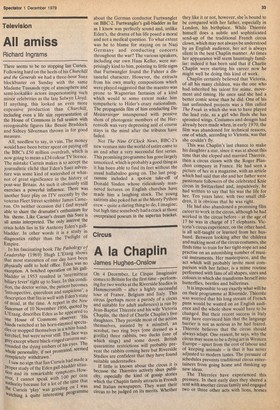Circus
A la Chaplin
James Hughes-Onslow
On 4 December, Le Cirque Imaginaire comes to Britain for the first time —performing for two weeks at the Riverside Studios in Hammersmith — after a highly successful tour of France, Belgium and Italy. This circus (perhaps more a parody of a circus and suitable for adult audiences) is run by Jean-Baptist Thierree and his wife Victoria Chaplin, the third of Charlie Chaplin's five daughters. They provide most of the action themselves, assisted by a minstrel, an acrobat, two ring boys (one dressed as a gorilla) three rabbits, two ducks (one of which sings) and some doves. British quarantine restrictions will probably prevent the rabbits coming here but Riverside Studios are confident that they have found suitable understudies. If little is known about the circus it i.s because the Thierrees actively shun publicity, especially the kind of gossip stories which the Chaplin family attracts in French and Italian newspapers. They want their circus to be judged on its merits. Whether they like it or not, however, she Is bound to be compared with her father, especially in London, his birthplace. While Thierree himself does a subtle and sophisticated send-up of the traditional French circus clown, which may not always be understood by an English audience, her act is always silent in the best Chaplin manner. At times her appearance will seem hauntingly familiar: indeed it has been said that if Charlie Chaplin were starting his career now he might well be doing this kind of work.
Chaplin certainly believed that Victoria, of all his many children, was the one who hadinherited his talent for mime, movement and timing. He once said she had a better comic sense than he did. One of his last unfinished projects was a film called The Freak in which she was to have played the lead role, as a girl who finds she has sprouted wings. Costumes and designs had already been made when, in early 1970, the film was abandoned for technical reasons, one of which, according to Victoria, was that she couldn't fly.
This was Chaplin's last chance to make his daughter a star, since it was at about this time that she eloped and married Thierree, then a circus clown with the Roger Planchon company in France. He had seen a picture of her in a magazine, with an article which had said that she and her father were passionate followers of the celebrated Knie circus in Switzerland and, impulsively, he had written to say that his was the life for her. Ten years later, with two small children, it is obvious that he was right. He had also abandoned a promising film career to work in the circus, although he had worked in the circus before — at the age of 17 he was in charge of 17 elephants. Victoria's circus experience, on the other hand, is all self-taught or learned from her husband. Between looking after the children and making most of the circus costumes, she finds time to train for her tight-rope act and practise on an astonishing number of musical instruments. Her masterpiece, and the act which will probably invite most comparison with her father, is a mime routine performed with fans of all shapes, sizes and colours in which she transforms herself into butterflies, beetles and ballerinas.
It is impossible to say exactly what will be on their programme at Riverside. Thierree was worried that his long stream of French puns would be wasted on an English audience and the whole show would have to be changed. But their recent success in Italy may have convinced him that the language barrier is not as serious as he had feared. Thierree believes that the circus should always adapt. One reason, he says, why the circus may seem to be a dying art in Western Europe — apart from the cost of labour and of keeping animals — is that it has never adjusted to modern tastes. The pressure of schedules prevents traditional circus entertainers from going home and thinking up new ideas.
The Thierrees have experienced this pressure. In their early days they shared a tent with another circus family and engaged two or three other acts with lions, horses and chimpanzees. Despite their love of animals, living next to a cage of lions was not conducive to a happy family life or to creative thinking. Now they make a point, when not travelling the provinces in their caravans, of returning to their farmhouse near Paris for several months a year to devise new schemes.
This is perhaps a luxury that other circus families could not afford, yet Thierree seems far from convinced that the Chaplin connection is a helpful one. He worries that public attention could upset the precarious family business he has built up. Victoria, who has been in the public eye all her life, is less nervous of public acclaim than he is; but even she has expressed fears that exploiting her family name could spoil the whole thing.
So refreshingly reticent are the Thierrees about their work that it has been said that finding Le Cirque Imaginaire when it is on tour is like tracking down a rare bird. It is a bird which, once spotted, is to be examined seriously rather than superficially. Otherwise it may fly back to its French farmhouse and never return.












































 Previous page
Previous page